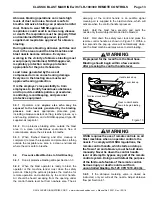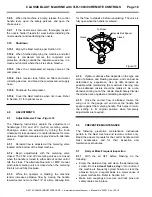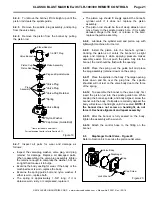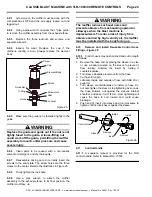
CLASSIC BLAST MACHINE with TLR-100/300 REMOTE CONTROLS
Page 12
© 2018 CLEMCO INDUSTRIES CORP.
www.clemcoindustries.com
Manual No. 22501, Rev. I 02/18
3.2.9
Make sure that the safety petcock located on the
inlet valve is open. Open position is when the lever is
aligned with the petcock, as shown in Figure 11.
Figure
11
3.2.10
Make sure the remote control handle lever is in
the up (no blast) position, as shown in Figure 12, and
that the handle lever and safety lock move freely.
Figure
12
WARNING
A separate manual is supplied with the remote
control handle. Do not operate the machine
before reading the remote control handle
operating instructions.
3.2.11
Make sure the rubber seal under the handle
lever does not seal the opening on the control handle,
unless the safety lever lock is intentionally folded down.
WARNING
Malfunctioning control handles can cause
unintentional actuation of a blast machine or
prevent a machine from deactivating upon
release. Malfunctioning control handles must
be taken out of service immediately and
repaired or replaced. Serious injury or death
could result from unintentional blasting.
3.2.12
Close the air valve on the compressor. Start the
compressor, and bring it to operating temperature and
pressure. The pressure must be more than 50 psi, but
must not exceed the blast machine’s rated pressure.
3.2.13
Slowly open the compressor air valve to
pressurize the air-supply line. Listen for open lines or air
leaks.
3.2.14
Load abrasive into the machine by following the
instructions in Section 3.8.
3.2.15
Do not allow anyone near the blast machine
except machine tenders who are appropriately attired in
approved personal protective equipment as noted in
Section 3.3.
WARNING
Everyone except for the blast operator or blast
machine tender must stay clear of the blast
machine. The machine tender or blast operator
may pressurize or depressurize the machine at
any time, which can cause abrasive to vent
under pressure, causing dust and toxins to
become airborne. Noise is produced by the
sudden release of compressed air when the
machine is pressurized or depressurized. These
conditions can cause injury. Both the operator
and machine tender must wear suitable
personal protective equipment including an
approved respirator, plus approved eye, face,
and hearing protection.
3.3 Blasting
Attire
WARNING
Before blasting, test the coating and substrate
for toxic materials, such as lead or other heavy
metals, or asbestos. These hazards require
special measures to protect the operators and
the environment.
Obtain a safety data sheet (SDS) for the blast
abrasive to identify hazardous substances.
Silica sand (crystalline) can cause silicosis,
lung cancer, and breathing problems in
exposed workers. Slag abrasives may contain
trace amounts of toxic metals
such as arsenic,
beryllium, and cadmium. Any abrasive dust has
potential to cause lung disease.
The lever lock must be folded down before the
control handle lever can be pressed.
Lever Lock
Prevents control handle lever
from being pressed down to the
blast position.
Control Handle Lever
Shown in the UP no-blast position.
Closed
Open














































